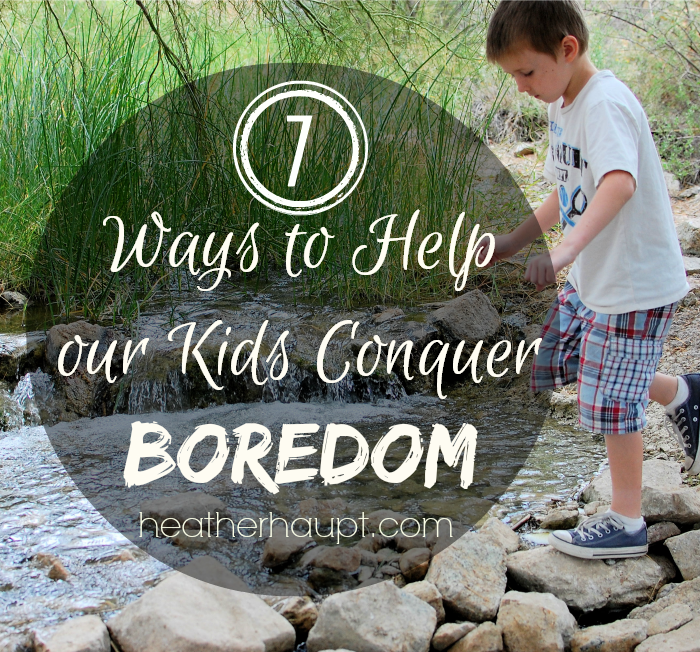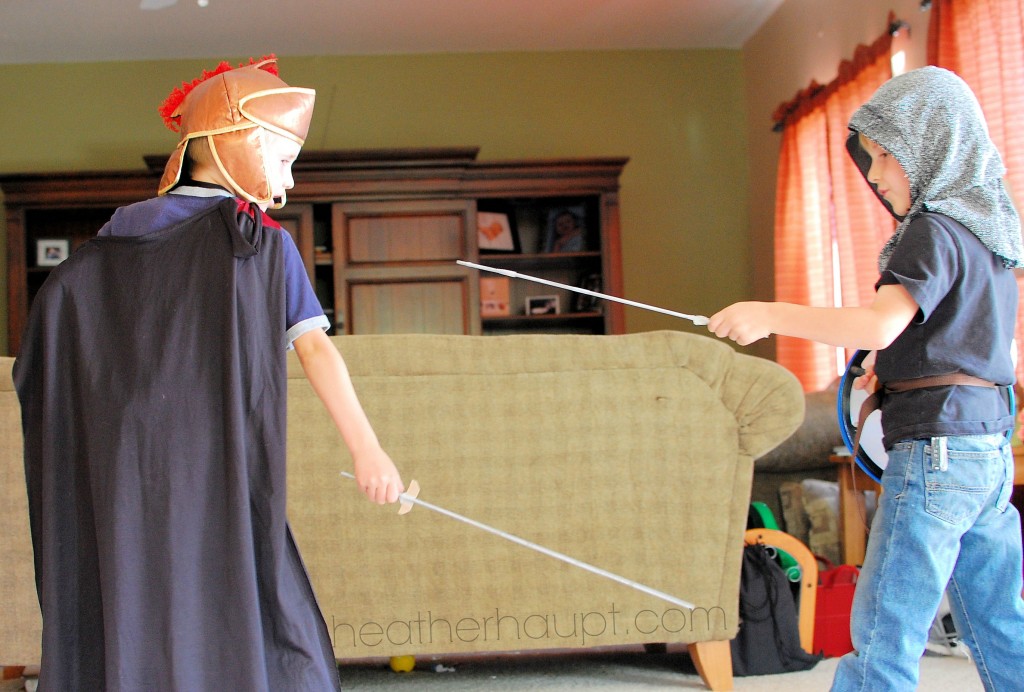
I’m waxing nostalgic about embracing the good ‘ol days and learning to simply be over at The Busy Mom today. And all of that got me thinking about the topic of boredom…
I’m sure we’ve all encountered kids who say, “I’m bored.” or “Can we just go somewhere today?” or “What are we going to do today?” Maybe you are turning the TV off or taking back your iPad when your kids start to whine for just one more show or 10 more minutes…
We live in an entertainment, entitlement culture where everything is about what someone or something else is going to do for us. It is so ingrained in our cultural ethos that it can be difficult to even recognize these influences. Summer tends to be put this on full-display.
How do we help our children cultivate creativity and conquer boredom without relying on us at every turn? While this certainly isn’t an exhaustive list, I have 7 tips to get you started. **Remember that parenting is an art and how you choose to implement these principles will look different for each family**

1. Realize that boredom is not some kind of disease.
It’s super easy to fall into the trap that we need to solve this problem of boredom. It is not some kind of disease that we as loving, caring parents need treat.
It’s ok for our children to be bored. Repeat after me… It’s ok for our children to be bored. Boredom breeds curiosity. Boredom breeds innovation. If we let it, boredom can lead to our children learning to creatively occupy themselves. Keep that in mind as you read the rest of these tips. Our goal should be to help our children navigate through this themselves. Now of course on the flip side, boredom can also breed destruction. So a wise parent will set up boundaries and parameters that clearly lay out your family expectations of behavior.
2. Turn off the screens… or at least place severe limits.
I’ve made the case before in great detail and it bears repeating again. Screen-time, among other things, robs us of time and opportunity for other creative pursuits. If your children struggle with finding things to do with themselves, start by removing or at least limiting this medium that can so easily become a crutch. We have seasons of no screen-time in our home and times when we just put limits on it. Growing up, my parents went through a period of putting the TV in the attic for a few months at a time because they deemed that the necessary step. We have not felt it necessary to do this in our family (although, I’ve gone “dark” for my own benefit from time to time.) As kids wean off the screen-time, they will learn how to occupy themselves in creative ways.
3. Read them good books.
Books ignite the imagination. It opens their minds to new worlds and often times it fuels their free play. Read a story and then act it out. Include beautiful picture books and chapter read-aloud books. We recently read Little House in the Big Woods. The boys were obsessed with hunting like Pa for a few days.

4. Encourage them to play by themselves.
We live in a culture that tends to promote shuttling our kids from event to event. When they are home, there is tons of mommy guilt out there that says you need to plan all kinds of creative memory making opportunities. Kids simply don’t need all of this. If they are playing well on their own leave them to play. My mom told me a story about how she had planned this really cool learning activity and came back to our room to fetch us. She stopped herself at the door when she noticed that we were in the midst of writing a play and making plans to “produce” it later that day. She wisely realized the value in our self-directed activity and put her super-cool plans on hold for another time.
Sometimes this might mean that you have to get down and teach them how to play. I’ve talked to many families who have shared with me that their young children don’t know how to play on their own. My kids have gone through periods where this has been the case – especially when they were younger. Sometimes, we need to get down on their level and give them some prompts to get the creative juices flowing. You can throw out some ideas such as playing house, store, doctor, etc. In these situations, you are the facilitator, you ask the questions. Try to encourage them to problem solve. If you are playing doctor, you might ask your child where to set up the office, ask them what they need in the office and what objects around your house could stand in for common tools a doctor might use. The idea here is that you want to keep it as open-ended as possible. Teach your kids to think outside the box, using their imagination and what they have around them.

5. Send them outside!
Send them outside. You could encourage them to build a fort, mud kitchen, have a battle, play house, try to catch lizards. Or don’t give them any ideas. Simply send them outside with instructions to “just play and don’t come back until dinner time.” As long as they are past the toddler years, let them find a space where there is some semblance of “alone” so that they can create, dream, play. My kids gravitate to the side yards and lose themselves in imaginary worlds. I only intervene if play gets unnecessarily rough or destructive (like the time they were caking the side of my house with mud).
Richard Louv, in his fantastic book, Last Child in the Woods, mentions research revealing that when children play in natural play spaces, they’re far more likely to invent their own games, than in more structured settings — a key factor in becoming self-directed and inventive as children and later in life.
6. Give them Work.
Pay attention to this one. It’s GOLDEN. When I was a girl, uttering the words “I’m bored” meant getting assigned extra chores. We learned quickly to find creative ways to occupy ourselves. My mom’s philosophy was that if we didn’t know what do to then she would find more than enough constructive ways that we could help around the house. Putting in the mental effort to dream up something to do soon became far more tantalizing then the menial task of scrubbing baseboards. My mom was so devoted to this that she even put our co-op buddies to work one day when they complained of co-op being boring. That was the first and last time they did that. Trust me, this works. And if for some reason it doesn’t, you’ll have sparkling baseboards and shining windows indefinitely!
7. Resist the urge to fill your schedule.
Too much of a good thing, is too much. Where I live, you could literally sign your child up for a different program or activity to occupy their every waking moment. Again, mommy guilt can play a factor here as you hear what great programs everyone else is doing. I’m not saying that all programs and activities are bad. We did VBS two weeks ago and are in the middle of swim lessons right now. We simply want to protect our children’s free-time so they have that time to be bored… Ironically enough, an article came out this last week on this very topic that I shared on facebook. It lays out the many benefits of leaving room in your summer schedule for plenty of free-play! Let’s buck the cultural trends and move towards being more people-focused instead of program focused. It’ll be easier on our pocket books, our sanity, and our children’s development.



This all sounds great, really it does, but I have a 12 yr old son who’s siblings are grown, so therefore he’s basically an only child at home and being homeschooled. He does get a lot of screen time and I do monitor it and am starting again to limit it, but he doesn’t have access to play with other children everyday and he gets so bored even though he does have a bike and all his toys. I am at a loss as to what to do. Today I did give him extra chores, but all he did was gripe and talk back. What do I do? Thanks.
That is a hard one. I would hold steady on holding the limits that you feel are important with screen time and work to direct him towards picking up some hobbies. Sometimes having a {self-directed} project can really help capture the imagination and attention and give you something constructive to do with downtime. That’s one idea that comes to mind that is good for those junior high/high school years when toys start to lose that appeal.
Great post my friend! Thank you for the encouragement. Yes, work is part of the picture around these here parts. I like your ideas. Hugs to you. 🙂
Love it! Great ideas, Heather and I can’t believe how big your kiddos are! (especially the baby who looks an awful lot like a BIG girl!)